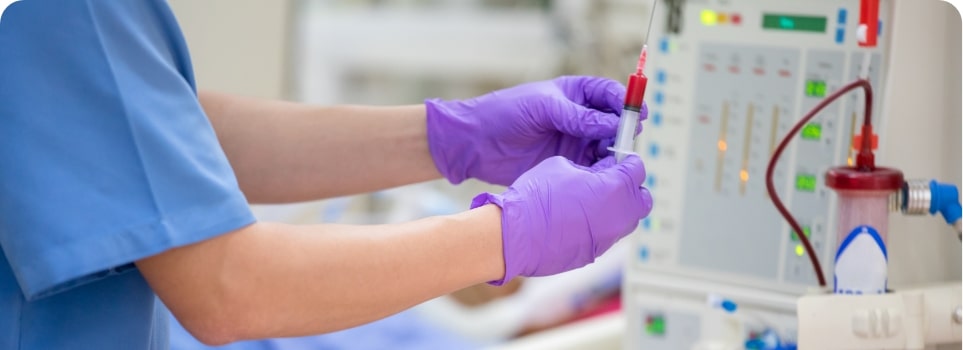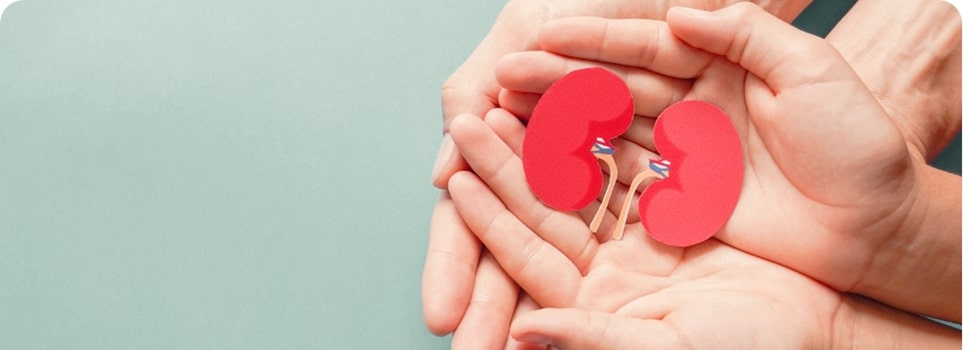Dialysis
Dialysis is a medical treatment in which waste products are removed from the blood artificially, effectively taking over the job of the kidneys. There are two main forms of dialysis; haemodialysis and peritoneal dialysis.
Haemodialysis
In haemodialysis (HD), a machine which filters and cleans the blood is used. Blood is taken from your body and runs into the dialysis machine. Here, the unwanted wasted products move from the blood into a special fluid (dialysate) kept in the machine.
The blood is now clean and is returned to the body.
In order for dialysis to work, the blood must flow into the dialysis machine efficiently. This is usually achieved by one of several methods. Usually, the most common and preferred way is by joining an artery to a vein in the arm, referred to as a fistula.
This allows a site from which to take blood for HD that is strong enough to withstand the needle and will reliably provide good blood flow each time. The procedure to create a fistula is performed by a surgeon in hospital, and patients are normally able to go home on the same day. In patients where the vessels are not suitable for a fistula, a synthetic graft with the same purpose can be placed in the arm in a similar operation. Both fistulae and grafts take several weeks to ‘mature’ before they are strong enough to be used for dialysis.
In patients who need emergency dialysis or in cases where the fistula or graft is still maturing, a central venous catheter (CVC) may be used. This hollow tube, also known as a line, is inserted into a neck vein. A line can be used for dialysis straight away after insertion. Due to possible risks such as infection or blockage, a fistula is generally preferred over a line for
long-term dialysis treatment.
HD sessions may take place either at a dialysis centre or at home. In centre dialysis, you will normally have several sessions a week, each lasting around four to five hours. These sessions are usually held on alternating days. In home HD, the dialysis machine and equipment is kept in your house. Sessions are often more frequent for HD at home compared to at a centre but can offer better flexibility around your schedule. Some patients also report feeling better with more frequent dialysis sessions. You will receive training on how to perform home HD if you wish to choose this route. In some cases, it is possible to do nocturnal HD at home. This takes place as you are asleep, allowing each session to last a longer period of time. This is often gentler on the body and may filtrate the blood more effectively. Nocturnal home HD gives you more time to do the things you want to during the day.
Peritoneal Dialysis
Peritoneal dialysis (PD) is another form of renal replacement therapy. Similarly to HD, a special fluid is used to remove waste from the blood and clean it. While blood is taken from and returned to a vein in HD, in PD fluid is drained in and out of the abdominal cavity, performing a similar function. PD works because the peritoneum (lining of the inside of the abdomen) has a rich blood supply, allowing substances to cross from the bloodstream into the fluid.
In order for fluid to be passed in and out, a special soft tube called a Tenckhoff catheter, is inserted into the abdomen during a procedure at hospital. This is the tube through which fresh PD fluid flows into the abdomen and used fluid is drained.
There are two main types of PD – continuous ambulatory peritoneal dialysis (CAPD) and automated peritoneal dialysis (APD), which are done at home.
CAPD
In CAPD, a series of ‘fluid exchanges’ take place each day. A fluid bag is connected to your catheter, used PD fluid is drained and your abdomen is filled with fresh fluid. This takes around half an hour. After disconnecting the bag and closing the catheter cap, you are able to resume your daily activities while the fluid removes waste products from your blood. There are normally four to six of these exchanges to be done each day.
Further information can be found on
the Welsh Kidney Network website
APD
In APD, dialysis happens overnight as you sleep. The machine drains out used fluid from the day, and fills your abdomen with new fluid. Several cycles of filling and drainage will take place during your sleep, with fluid left in the abdomen during the day until it is time to repeat the process at night. This allows flexibility for you to get on with your day.
PD may not be the best form of dialysis for everyone. For example, patients who have inflammatory bowel disease or have had previous major surgery in the abdomen, may be more suitable for haemodialysis. Your doctor can your questions and reach a shared decision on which form of dialysis is most appropriate for you.
Treatment types

Dialysis
Dialysis is a medical treatment in which waste products are removed from the blood artificially, effectively taking over the job of the kidneys.

Kidney Transplantation
Kidney transplantation is the other main form that makes up renal replacement therapy for individuals with end-stage kidney disease.